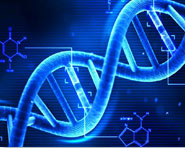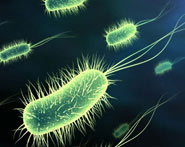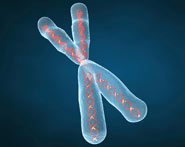


 النبات
النبات
 الحيوان
الحيوان
 الأحياء المجهرية
الأحياء المجهرية
 علم الأمراض
علم الأمراض
 التقانة الإحيائية
التقانة الإحيائية
 التقنية الحيوية المكروبية
التقنية الحيوية المكروبية
 التقنية الحياتية النانوية
التقنية الحياتية النانوية
 علم الأجنة
علم الأجنة
 الأحياء الجزيئي
الأحياء الجزيئي
 علم وظائف الأعضاء
علم وظائف الأعضاء
 الغدد
الغدد
 المضادات الحيوية
المضادات الحيوية|
Read More
Date: 8-12-2020
Date: 2025-05-04
Date: 2025-01-16
|
The complement system is a collection of circulating and cell membrane proteins that play important roles in host defense against microbes and in antibody- mediated tissue injury. The term complement refers to the ability of these proteins to assist, or complement, the activity of antibodies in destroying (lysing) cells, including microbes. The complement system may be activated by microbes in the absence of antibody, as part of the innate immune response to infection, and by antibodies attached to microbes, as part of adaptive immunity.
The activation of the complement system involves sequential proteolytic cleavage of complement proteins, leading to the generation of effector molecules that participate in eliminating microbes in different ways. This cascade of complement protein activation, like all enzymatic cascades, is capable of achieving tremendous amplification, because even a small number of activated complement molecules produced early in the cascade may generate a large number of effector molecules. Activated complement proteins become covalently attached to the cell surfaces where the activation occurs, ensuring that complement effector functions are limited to the correct sites. Normal host cells possess several regulatory mechanisms that inhibit the activation of complement and the deposition of activated complement proteins, thus pre venting complement-mediated damage to healthy cells.
Pathways of Complement Activation
There are three major pathways of complement activation: the alternative and lectin pathways are initiated by microbes in the absence of antibody, and the classical pathway is initiated by certain isotypes of antibodies attached to antigens (Fig. 1). Several proteins in each pathway interact in a precise sequence. The most abundant complement protein in the plasma, C3, plays a central role in all three pathways. The early steps of all three pathways function to generate a large number of functionally active fragments of C3 bound to the microbe or cell where the complement pathway was initiated. (By convention, the smaller proteolyic fragment of any complement protein is given the “a” suffix, and the larger piece is the “b” fragment; C2 is an exception.)
• The alternative pathway of complement activation is triggered by spontaneous hydrolysis of C3 in plasma at a low level. The breakdown products of C3 are unstable, and, in the absence of infection, are rap idly degraded and lost. However, when a breakdown product of C3 hydrolysis, called C3b, is deposited on the surface of a microbe, it forms stable covalent bonds with microbial proteins or polysaccharides. The microbe-bound C3b binds another protein called Factor B, which is then cleaved by a plasma protease called Factor D to generate the Bb fragment. This fragment remains attached to C3b, and the C3bBb complex functions as a proteolytic enzyme, called the alternative pathway C3 convertase, that breaks down more C3. The C3 convertase is stabilized by properdin, a positive regulator of the complement system. As a result of this enzymatic activity, many more C3b and C3bBb molecules are produced and become attached to the microbe. Some of the C3bBb molecules bind an additional C3b molecule, and the resulting C3bBb3b complexes function as C5 convertases, to cleave the complement protein C5 and initiate the late steps of complement activation.
The classical pathway of complement activation is triggered when IgM or certain subclasses of IgG (IgG1 and IgG3 in humans) bind to antigens (e.g., on a microbial cell surface). As a result of this binding, adjacent Fc regions of the antibodies become accessible to and bind the C1 complement protein (which is made up of a binding component called C1q and two proteases called C1r and C1s). The attached C1 becomes enzymatically active, resulting in the binding and sequential cleavage of two proteins, C4 and C2. One of the C4 fragments that is generated, C4b, becomes covalently attached to the antibody or to the microbial surface where the antibody is bound, and then binds C2, which is cleaved by active C1 to yield the C4b2a complex. This complex is the classical path way C3 convertase, which functions to break down C3, and the C3b that is generated again becomes attached to the microbe. Some of the C3b binds to the C4b2a complex, and the resultant C4b2a3b com plex functions as a C5 convertase, which cleaves the C5 complement protein.
• The lectin pathway of complement activation is initiated not by antibodies but by the attachment of plasma mannose-binding lectin (MBL) to microbes. Serine proteases structurally related to C1s of the classical pathway are associated with MBL and serve to activate C4. The subsequent steps are essentially the same as in the classical pathway.
Fig1. Early steps of complement activation. A, The steps in the activation of the alternative, classical, and lectin pathways. Although the sequence of events is similar, the three pathways differ in their requirement for antibody and the proteins used. Note that C5 is cleaved by the C5 convertase but is not a component of the enzyme.
The net result of these early steps of complement activation is that microbes acquire a coat of covalently attached C3b. Note that the alternative and lectin pathways are effector mechanisms of innate immunity, whereas the classical pathway is a mechanism of adaptive humoral immunity. These pathways differ in their initiation, but once triggered, their late steps are the same.
The late steps of complement activation are initiated by the binding of C5 to the C5 convertase and subsequent proteolysis of C5, generating C5b (Fig. 2).
The remaining components, C6, C7, C8, and C9, bind sequentially to a complex nucleated by C5b. The final protein in the pathway, C9, polymerizes to form a pore in the cell membrane through which water and ions can enter, causing death of the microbe. The C5-9 complex is called the membrane attack complex (MAC), and its formation is the end result of complement activation.
Fig2. Late steps of complement activation. A, The late steps of complement activation start after the formation of the C5 convertase and are identical in the alternative and classical pathways. Products generated in the late steps induce inflammation (C5a) and cell lysis (membrane attack complex). B, Properties of the proteins in the late steps of complement activation.
Functions of the Complement System
The complement system plays an important role in the elimination of microbes during innate and adaptive immune responses. The main effector functions of the complement system are illustrated in Fig. 3.
Fig3. The functions of complement. A, C3b opsonizes microbes and is recognized by the type 1 complement receptor (CR1) of phagocytes, resulting in ingestion and intracellular killing of the opsonized microbes. Thus C3b is an opsonin. CR1 also recognizes C4b, which may serve the same function. Other complement products, such as the inactivated form of C3b (iC3b), also bind to microbes and are recognized by other receptors on phagocytes (e.g., type 3 complement receptor, a member of integrin family of proteins). B, Membrane attack complex creates pores in cell membranes and induces osmotic lysis of the cells. C, Small peptides released during complement activation bind to receptors on neutrophils and other leukocytes and stimulate inflammatory reactions. The peptides that serve this function are mainly C5a and C3a, released by proteolysis of C5 and C3, respectively.
• Opsonization. Microbes coated with C3b are phagocytosed by virtue of C3b being recognized by complement receptor type 1 (CR1, or CD35), which is expressed on phagocytes. Thus, C3b functions as an opsonin. Opsonization is probably the most important function of complement in defense against microbes.
• Cell lysis. The MAC can induce osmotic lysis of cells, including microbes. MAC-induced lysis is effective only against microbes that have thin cell walls and little or no glycocalyx, such as the Neisseria species of bacteria.
• Inflammation. The small peptide fragments C3a and C5a, which are produced by proteolysis of C3 and C5, are chemotactic for neutrophils, stimulate the release of inflammatory mediators from various leukocytes, and stimulate movement of leukocytes and plasma proteins across the endothelium into tissues. In this way, complement fragments induce inflammatory reactions that also serve to eliminate microbes.
In addition to its antimicrobial effector functions, the complement system stimulates B cell responses and antibody production. When C3 is activated by a microbe by the alternative pathway, one of its breakdown products, C3d, is recognized by complement receptor type 2 (CR2) on B lymphocytes. Signals delivered by this receptor enhance B cell responses against the microbe. and is an example of an innate immune response to a microbe (complement activation) enhancing an adaptive immune response to the same microbe (B cell activation and antibody production). Complement proteins bound to antigen-antibody complexes are recognized by follicular dendritic cells in germinal centers, allowing the antigens to be displayed for further B cell activation and selection of high-affinity B cells. This complement-dependent antigen display is another way in which the complement system promotes antibody production.
Inherited deficiencies of complement proteins result in immune deficiencies and, in some cases, increased incidence of autoimmune disease. Deficiency of C3 results in increased susceptibility to bacterial infections that may be fatal early in life. Deficiencies of the early proteins of the classical pathway, C2 and C4, may have no clinical consequence, may result in increased susceptibility to infections, or are associated with an increased incidence of systemic lupus erythematosus, an immune complex-mediated autoimmune disease. The increased incidence of lupus may be because the classical pathway functions to eliminate immune complexes from the circulation, and these complexes accumulate in individuals lacking C2 and C4. In addition, complement deficiencies may lead to defective signaling in B cells and a failure of B cell tolerance . Deficiencies of C9 and MAC formation result in increased susceptibility to Neisseria infections. Some individuals inherit polymorphisms in the gene encoding MBL, leading to production of a protein that is functionally defective; such defects are associated with increased susceptibility to infections. Inherited deficiency of the alternative pathway protein properdin also causes increased susceptibility to bacterial infection.
Regulation of Complement Activation
Mammalian cells express regulatory proteins that inhibit complement activation, thus preventing complement-mediated damage to host cells (Fig. 4). Many such regulatory proteins have been described, and defects in these proteins are associated with clinical syndromes caused by uncontrolled complement activation.
Fig4. Regulation of complement activation. A, C1 inhibitor (C1 INH) prevents the assembly of the C1 complex, which consists of C1q, C1r, and C1s proteins, thereby blocking complement activation by the classical pathway. B, The lipid-linked cell surface protein decay-accelerating factor (DAF) and the type 1 complement receptor (CR1) interfere with the formation of the C3 convertase by blocking the binding of Bb (in the alternative pathway) or C2a (in the classical pathway). Membrane cofactor protein (or CD46) and CR1 serve as cofactors for cleavage of C3b by a plasma enzyme called factor I, thus destroying any C3b that may be formed (not shown).
• A regulatory protein called C1 inhibitor (C1 INH) stops complement activation early, at the stage of C1 activation. Deficiency of C1 INH is the cause of a disease called hereditary angioedema. C1 INH is a serine protease inhibitor that functions as a major physiologic inhibitor of the cleavage of kallikrein, the precursor of the vasoactive molecule bradykinin. Therefore, C1 INH deficiency results not only in increased complement activation but also increased proteolytic activation of bradykinin, and this is the main reason for the vascular changes that lead to leakage of fluid (edema) in many tissues.
• Decay-accelerating factor (DAF) is a glycolipid-linked cell surface protein that disrupts the binding of Bb to C3b and the binding of C4b to C2a, thus blocking C3 convertase formation and terminating complement activation by both the alternative and the classical pathways. A disease called paroxysmal nocturnal hemoglobinuria results from the acquired deficiency in hematopoietic stem cells of an enzyme that synthesizes the glycolipid anchor for several cell-surface proteins, including the complement regulatory proteins DAF and CD59. In these patients, unregulated complement activation occurs on erythrocytes, leading to their lysis.
• A plasma enzyme called Factor I cleaves C3b into inactive fragments, with membrane cofactor protein (MCP) and the plasma protein Factor H serving as cofactors in this enzymatic process. Deficiency of the regulatory proteins Factors H and I results in increased complement activation and reduced levels of C3 because of its consumption, causing increased susceptibility to infection. Mutations in Factor H that compromise its binding to cells are associated with a rare genetic disease called atypical hemolytic uremic syndrome, in which there are clotting, vascular, and renal abnormalities. Certain genetic variants of Fac tor H are linked to an eye disease called age-related macular degeneration.
These regulatory proteins are made by vertebrate host cells but not by microbes. Because microbes lack these regulatory proteins, the complement system can be activated on microbial surfaces much more effectively than on normal host cells. Even in vertebrate cells, the regulation can be overwhelmed by too much complement activation. For instance, host cells can become targets of complement if they are coated with large amounts of antibodies, as in some hypersensitivity diseases .



|
|
|
|
لشعر لامع وكثيف وصحي.. وصفة تكشف "سرا آسيويا" قديما
|
|
|
|
|
|
|
كيفية الحفاظ على فرامل السيارة لضمان الأمان المثالي
|
|
|
|
|
|
|
العتبة العباسية المقدسة تجري القرعة الخاصة بأداء مناسك الحج لمنتسبيها
|
|
|